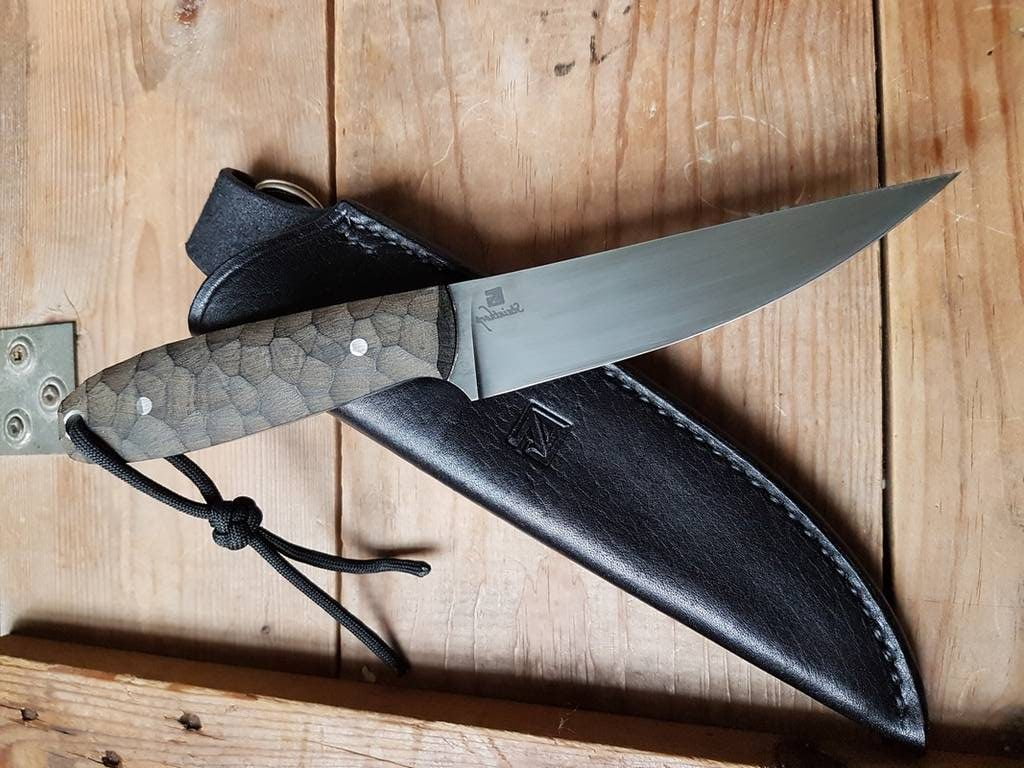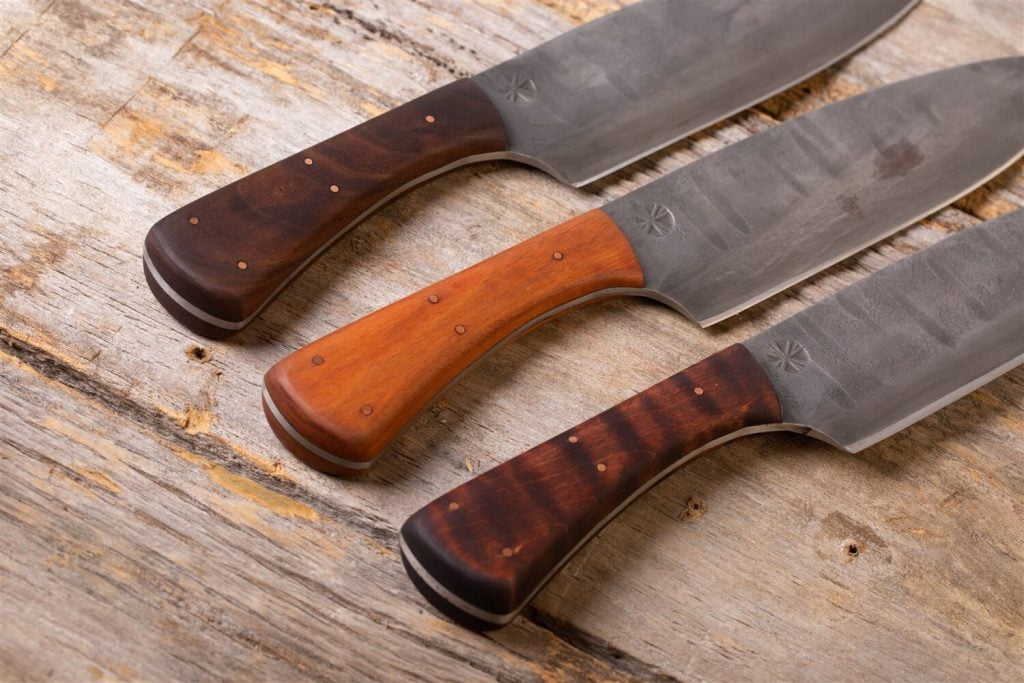Critical Properties of Knife Making Steel
Whether you have taken up knife making as a hobby or seeking a top-quality blade, you must ensure that your knife is well-built so that it performs well. Many critical properties of the blade will determine whether your knife will fracture or dull. It is essential to choose the correct steel type for the knife-edge, dependent on your purpose. Ultimately, steel is an alloy (although not all steels are called ‘alloy steel’), meaning that it is a combination of carbon and iron. Steel often gets enhanced with a limited number of alternative elements, such as Manganese, Nickel, Sulphur, Cobalt and Phosphorus, that provide unique properties depending on the knife’s desired application. If the blade is pure steel, it is carbon steel. Therefore, there are critical properties that you should pay attention to when knife making to ensure that you optimise the performance of your blade, such as:
Hardness
Knife steel hardness is a gauge of the blade’s strength and its ability to resist sustained deformation. Hardness is measured using the industry standard, non-destructive metallurgical testing system, the Rockwell C scale, often abbreviated as the HRC. So when looking for the correct knife making steel, check out its hardness properties.
Toughness
It is never easy to fix a knife when it is damaged. Toughness is the relative resistance of the knife steel to damage like cracking, fracturing, breaking, or chipping which can occur in edges when the blade is under applied pressure or impact. There is no standardised form of measurement for toughness, but Charpy and Izod tend to be popular. If the steel of your blade rates highly on the Rockwell C Scale, it will likely have a low toughness rating. Thus, the more brittle the steel, the more prone it is to shatter.
Wear Resistance
Wear resistance is often aligned with the steel’s hardness, but it is also determined by the steel’s chemistry. Wear resistance is the steel’s capability to hold out against edge corrosion from both abrasive and adhesive wear throughout cutting use. Abrasive wear, which is the cause of most wear-related failures, happens when more rigid particles scrape or gouges a softer surface. In contrast, adhesive wear occurs when debris is displaced from one surface and affixes itself to another. Both these forms of friction can cause tearing, scraping, and shattering to the blade.
Corrosion Resistance
Many external environmental factors threaten the blade’s structure by bringing about rusting, such as humidity, moisture, and salt. Therefore, corrosion resistance is important in the steel’s ability to resist degeneration. However, high corrosion resistance can be detrimental to the overall blade edge performance so keep that in mind when choosing your steel for knife making.
Edge Retention
Edge retention relates to the steel blade’s capacity to maintain its sharpness after a prolonged period of use. To ensure your blade has high-level edge retention, you will need to ensure that when manufacturing, you choose a steel that resists deformation.
Tool Steel
Tool steels are one of the most popular choices for knife makers. Generally, they comprise carbon steels that are enriched with additional alloying elements to improve their mechanical properties. Tool steels are identifiable by their hardness, durability, strength and excellent wear resistance to corrosion and deformation.
Tool Steel Grades for Knife Making
O1
O1 Tool Steel is generally considered the most popular non-shrinking, oil-hardening tool steel plate available on the market for knife making. This manganese-chromium tungsten steel is suitable for a wide range of cold work applications but has been proven as an excellent choice for knife making. The biggest benefit of using O1 for your project would be that it’s widely available and cost-effective. Furthermore, it’s easy to sharpen and finish knives due to its low wear resistance. On the other hand, knife makers have disused how difficult it is to anneal.
D2
D2 tool steel is one of the better steel options for knife making if you require high corrosion resistance and edge retention levels. This durable cold world steel is commonly used for heavy-duty tools, as D2 can retain its hardness up to temperatures of 425°C. D2 is still used as knife steel to this day, and although there are many other options available, they are often more expensive compared to D2. Although the powder metallurgy version is available of D2, which improve toughness and refine the microstructure, the standard version will continue to be a steel of choice due to its reputation and cost.
Benefits of Tool Steel for Knife Making
Tool steel has several advantages, as it offers sturdy and durable material and has a high level of hardness and toughness. Furthermore, depending on the grade, it can have an excellent cutting edge hold ability. It is also highly heat and abrasion-resistant, making it the ideal choice for cutting tool applications. The main types of knives that are made from tool steel includes everyday tactical and outdoor knives.

Weaknesses of Tool Steel for Knife Making
Tool steel can be less corrosion resistant than stainless steel and often is not appropriate if you want a soft finish to your knife, for example, a kitchen knife. Furthermore, weaknesses come in different forms depending on the grade of tool steel you’re using for your knife making project. We recommend reading further about your desired grade but remember that expensive steels have their place, and so do cheap steels as long as you know its limitations.
For more information on the tool steels we have to offer, give us a call on (+44)114 233 5291.
Carbon Steel
Carbon steel grades with high levels of carbon are suitable for knife making because they provide the blade with the hardness and strength needed to hold up against wear resistance. Carbon steel is an economical alternative to tool steels.
Carbon Steel Grades for knife making
C1045
C1045 is a medium carbon, medium tensile steel, which provides decent strength and toughness to the blade. It is versatile steel with a hardness that can be tempered to the knife maker’s liking. C1045 contains 0.3% to 0.6% carbon.
C1075
C1075 is medium-high carbon steel. Once tempered, it requires no heat treatment after forging, which leaves it with excellent versatility rates. The carbon content for C1075 is 0.7% to 0.8%.
C1090
C1090 is the most popular of the grades because it is a high-wear resistance carbon steel. Therefore, it is suitable for applications that require high durability rates. C1090 is typically harder than 1075 allowing it to provide better edge retention. The carbon content includes 0.85% to 0.98%.
Benefits of Carbon Steel for Knife Making
Carbon steel is desirable for knife making because it can give the blade the hardness and strength to hold up against wear resistance and deformation. Ultimately, carbon steel knives are known to stay extremely sharp for longer than other alternatives, and when they do become dull, they are easy to resharpen. This feature often means carbon steel is used for high-end kitchen knives.

Weaknesses of Carbon Steel for Knife Making
Carbon steel is susceptible to heat. Therefore, if it is tempered too rapidly, the knife will become brittle and may fracture, or too slowly, and the blade will be too soft and have a dull edge. Furthermore, knives made from carbon steel are more prone to environmental degradation, such as rusting, because they do not contain any alloying elements to protect them from corrosion.
Stainless Steel
Stainless steel knives are usually composed of ferritic or martensitic stainless steels. Ultimately, blades made with stainless steel comprise carbon steel with added chromium, giving it a higher resistance to the elements.
Stainless Steel Grades for knife making
420
420 is a popular martensitic stainless steel for knife making because it offers excellent corrosion resistance and good strength and hardness. 420 takes a magnetic form in both annealed and hardened conditions, but it only has maximum corrosion resistance when it is hardened and tempered. As such, it is suitable for industries that require a durable and delicate blade and performs well in applications, such as knives and cutlery.
440
440, otherwise known as the “razor blade steel”, is a hardenable carbon chromium stainless steel. The 440 family comes in four different grades, the 440A, 440B, 440C, and 440F, and provides superior corrosion and abrasion resistance. 440 is a popular choice for blades that require durability because it can attain the highest level of hardness out of all the stainless steels. Therefore, they are suitable for applications, such as high-quality knife blades.
Benefits of Stainless Steel for Knife Making
Stainless steel is very inexpensive and easy to manufacture. Furthermore, it is particularly effective for applications, such as cutlery materials, because it is very durable. The addition of chromium and other alloying elements to stainless steel give knives impressive corrosion resistance.
Weaknesses of Stainless Steel for Knife Making
Often, the blade cutting edge of a stainless-steel knife is not as sharp as carbon knives. Additionally, due to the carbides found in stainless steel, knives made from this steel type cannot be as readily sharpened.
Conclusion
Choosing the correct steel for your knife project requires you to undertake thorough research, as steel grades and types contain different properties. So, depending on your desired outcome for the finished product you are going to use different steel. If you’re making blades that are to be used in tooling or industrial areas, you should focus on tool steels such as O1 and D2. Kitchen knives should use stainless steel or carbon steel depending on if rust resistance is a feature you desire, and finally, for bowing knives or machetes you should opt for carbon steel. Get in touch for more information on our steel range and how we can help with your next knife making project.